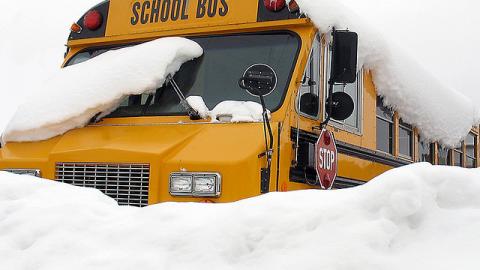Not surprisingly, technology is playing a large role in planning as school districts mull the possibility of using a state-wide flexible instructional day pilot program that would allow students to work from home on unscheduled days off, such as snow days.
Big Spring School District superintendent Rich Fry said that in spite of all secondary grade students having laptops, there is still concern over their ability to connect to the Internet. “We’re at about 93 to 94 percent connectivity,” he said. “But we have areas in our district that are still DSL, and if it’s truly bad enough weather (they will lose power altogether). This day isn’t about completing assignments, it’s truly a day of learning, so connectivity is absolutely a concern.”
While Big Spring School District has provided its secondary students with equipment, Carlisle Area School District does not have laptops for every student. However, the district has purchased 1,500 of them to give out to the students who do not have a personal device to use for their classes.
Stephanie Douglas, director of digital learning and technology for the district, said it’s an expensive endeavor to fund, but if the district submits a plan for the flexible instructional day program, there would definitely be other options available that would not require the use of technology.
“I don’t think that’s a realistic expectation that we’re providing students that don’t already have equipment to have that equipment,” she said. “So that is why our activities would have the option of being online or also offline for students that don’t have Internet in their home. We’re relying on students that have the technology at home or providing them an offline activity.”
Other districts, such as Cumberland Valley and South Middleton, have “bring your own technology” policies that encourage students at the middle and high school levels to use their own laptops, tablets and cellphones in class.
Al Moyer, the superintendent for South Middleton School District, said the cost of supplying every student in the district with a personal device would be expensive. Assistant Superintendent Joseph W. Mancuso III briefed the technology committee of the school board in October on preliminary discussions with Sharonn Williams, director of instructional technology, and Dennis Royer, computer network administrator. The administrators were looking at the feasibility of a digital conversion model to tailor instruction to every student through the use of a laptops or similar devices.
Moyer said that in the future, South Middleton School District could purchase laptops for the students who are unable to purchase a device or do not wish to use their personal device for school. In South Middleton, many of the students have their own devices that they use in the classroom, Moyer said.
“We are looking at 1-to-1 in the future, but we’re not there yet,” he said. “Maybe once we’re there, this might have more merit for us. The vast majority of our kids, especially at the high school, are utilizing (bring your own technology), but we’re not at 1-to-1 yet.”
Purchasing laptops for every student in a district would be a significant cost. For example, Carlisle district purchased 1,500 laptops, the district paid $699 for each, for a total of $1,048,500, Douglas said. Implementing a program that would allow students and teachers to work together outside of the school environment would further the financial burden, though Douglas didn’t have the cumulative cost of implementing such a program available.
Because of the cost, Douglas said it’s unlikely that the school will go to a 1-to-1 model any time in the near future. “This is also a time-intensive process, so there’s a lot of manpower involved also to get the laptops ready and prepare them for first use,” Douglas said. “We encourage students to bring their own devices, but if they didn’t, we provided it. Most of our students chose to take the school laptops.”
When Big Spring implemented its 1-to-1 laptop program for students in grades six through 12, the laptops cost the district about $900,000, Fry said. To get the whole program up and running, the district spent about $1.4 million in all. Fry said laptops and the Internet are how students receive information now, and even though he may not be quite ready to have classes over the Internet on days when snow storms keep schools from opening, he doesn’t want them to unplug when they hit the classroom.
“We’re examining the next step for elementary. We’re budgeted for it, but we’re still not real comfortable with what the next steps are at the elementary level; it’s very different,” Fry said. “The reality is, we have to look at things through their eyes, and what we don’t want to happen is our kids come into school and power down. That’s not preparing them for the society that they’re going to leave us for. So we have to support that type of learning as we move forward.” He said the district doesn’t necessarily need laptops for every student in order for a flexible instructional day to work, because the school can support literacy for the younger students through other activities.
In order to submit a plan to the Pennsylvania Department of Education for the flexible instructional days pilot program, a school district has to demonstrate that there are contingency plans for every possible scenario. One issue with this is making sure that these programs have an offline option for those who do not have connectivity either on that day or in general.
In the Big Spring School District, schools have hot spots in the parking lots, and it’s not uncommon to see a student sitting in the parking lot downloading an assignment or doing their homework because they don’t have a home Internet connection, Fry said.
Some students may have an Internet connection at home, but only one device for a household with multiple students. Requiring these students to do their school work online would be a burden for those families.
When the weather is bad, teachers and students may have other obligations, such as shovelling their driveway, helping family members, taking care of young children in the home or babysitting their siblings. They may also lose power, which would knock out Internet and possibly render technological devices useless if they weren’t charged properly, Douglas said.
In Carlisle district, about 89 percent of students at the high school level have access to the Internet on a regular basis, Douglas said. “Knowing that so many of our students, if they didn’t have a laptop or didn’t have a computer at home, they now have one,” she said. “That certainly supports the e-day idea. We now have — not all of our students, but 1,500 of them — have a device. We don’t know that they all have Internet … there’s about 10 percent that we’re not sure if they have Internet or not, and we know that some of them don’t have Internet and rely on a neighbor or a friend or an eatery or the library.”


